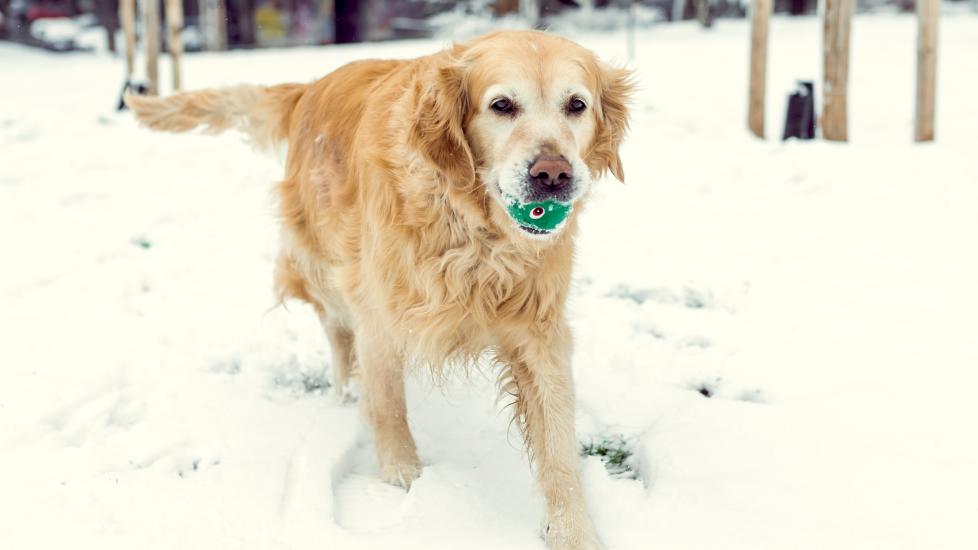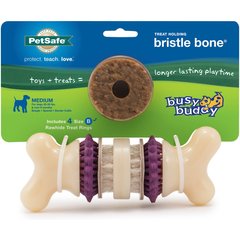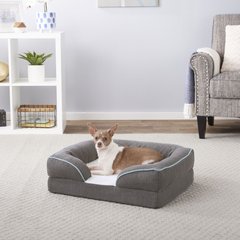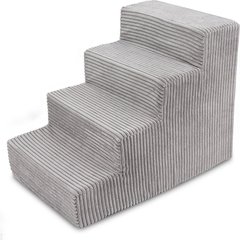Dog Arthritis and Cold Weather: Helping Your Dog's Arthritis Pain in Winter
Winter can bring a lot of joy, but for some people, it means more arthritis pain. Unfortunately, the same goes for our dogs. Learn how to help your dog’s arthritis pain in the winter to make the season a little easier.
Arthritis in Dogs
Arthritis in dogs, also known as degenerative joint disease or osteoarthritis, usually develops over the course of many years. As your dog ages, the cartilage in their joints breaks down, allowing the bones to rub together abnormally. The changes in the joint cause swelling, inflammation, and pain.
Unfortunately, arthritis is progressive, meaning it gets worse over time. While many pet parents think of arthritis as a disease of aging dogs, it can show up in younger pets if they’ve had an injury, such as a torn ligament in the knee, or have a developmental condition like hip dysplasia.
Does Cold Weather Affect a Dog’s Joints?
While many people have felt it when cold weather has affected their arthritic joints, the exact reasons for this aren’t known. A few factors are thought to add to winter joint pain.
-
Joint fluid thickening. The fluid inside the joints helps handle the shock of movement. In colder temperatures, this fluid thickens and cannot flow as freely, which may lead to joint stiffness.
-
Changes in barometric (atmospheric) pressure. Barometric pressure goes down in the winter. As a result, joint tissues grow larger. In joints with arthritis, this likely plays a role in pain.
-
Decreased activity levels. People and animals alike are less active in the winter, which helps cause joint stiffness and pain. You may put your daily dog walks on hold when the temperature falls below freezing. You’re also not likely to let your dog play outside for several hours in very cold temperatures.
It’s important to note that not everyone agrees that joint pain actually worsens in the winter. Rather than assuming your pet’s arthritis is worse because it’s winter, you should watch them for changes.
Signs of worsening arthritis include:
-
Decreased activity level
-
Unwillingness to play or exercise
-
Stiff movement, especially difficulty moving from sitting or lying down to standing (or vice versa)
-
Limping or lameness when walking
-
Changes to how your pet sits, such as leaving a leg extended
Caring for Your Dog’s Arthritis in Cold Weather
Many of these tips for caring for your dog’s arthritis in cold weather can be used all year. However, winter adds a few important considerations.
Weight
Obesity increases the pressure placed on your dog’s joints. Weight management can lower the strain on your dog’s joints, reducing pain and slowing the progression of arthritis.
Over half of dogs in the United States are considered overweight or obese. Pet parents often have a hard time figuring out if their pet is overweight, so you should ask your veterinary professional if your dog is at a good weight. Your veterinarian can help you develop a safe weight loss plan for your dog, if needed.
Some dogs may be predisposed to gain more weight in the winter. Two factors that may play a part in winter weight gain include lower activity levels and extra table scraps or holiday treats.
Exercise
Exercise helps prevent winter weight gain and provides your dog with mental stimulation while they’re spending more time indoors.
There are plenty of indoor activities you can do with your pet. Examples include:
- Hide and seek. Many dogs are happy to play this game with you! Have them sit in one room while you go hide in another. Then, call your dog and let them look for you.
- Puzzle games. There are plenty of indoor puzzles for pups to use that allow them to exercise their mind while also getting a reward. You can also throw treats throughout the home and have your pup sniff and search for hidden goodies. Just make sure you’re using low-calorie training treats.
- Keep away. If you have another person in your home, you can toss a desirable item back and forth while your dog tries to get the item. Make sure you sometimes let them win!
- Fetch. If you have a long hallway in your home, you can still play fetch in the winter months.
- Visit with friends. If you have a dog that enjoys playing with other dogs and is friendly toward other people, consider visiting friends. Your dog can get a lot of activity and interaction from playing with other dogs. You could also consider dog play dates or dog daycare.
If you have a senior pet or a dog that is limited in terms of mobility, you don’t need to push them too hard. Gentle tug-of-war play sessions, practicing commands your dog knows, or teaching your pet new tricks are all good examples of activities you can do with your older or less mobile pup.
If your dog has arthritis, you can also look for a physical rehabilitation practice for dogs. These centers will have great indoor exercises for your dog. Some even have underwater treadmills.
Rather than assuming your pet’s arthritis is worse because it’s winter, you should watch them for changes.
Support at Home
You may need to make some changes in your home this winter to work around your pet’s mobility changes.
Important considerations include:
-
Easily accessible food and water. Don’t make your dog go up and down the stairs to get to their bowls.
-
Comfortable beds. Consider placing a bed on every level of your home.
-
Ramps or small stairs. For dogs that have difficulty jumping, these can help them get off and on couches or beds.
-
Traction. Dogs with arthritis may slip more, and this is going to cause them more pain. Placing non-slip mats or carpet runners on hardwood or tile floors may help your pet keep their footing. Some dog boots can also help with traction.
Medications and Supplements for Dog Arthritis
In dogs with arthritis, prescription medications can decrease pain and joint swelling. Examples of medications your veterinarian may prescribe include:
-
Non-steroidal anti-inflammatory drugs (NSAIDs): carprofen, grapiprant, deracoxib, firocoxib
-
Steroids: prednisone. Note: Steroids cannot be given with NSAIDs.
-
Adequan® Canine (Polysulfated glycosaminoglycan): This is an injection that helps to restore joint lubrication (how slippery the joint is), decrease inflammation, and protect joint cartilage. It’s given twice weekly for up to four weeks.
-
Other pain medications: If your dog’s pain remains uncontrolled with NSAIDs, your veterinarian may recommend options like amantadine or gabapentin.
Never use your own pain medications for your dog. Some human pain medications, such as ibuprofen, are toxic to dogs.
Supplements that may be helpful for dog arthritis include omega-3 fatty acids or glucosamine with chondroitin. Speak with your veterinarian about supplements before adding them to your pet’s regiment.
Other treatment recommendations for arthritis can include:
- Prescription diets designed to improve mobility
- Acupuncture
- Laser therapy
- Physical rehabilitation
Winter doesn’t have to mean more pain for your arthritic dog. Speak with your veterinarian about all treatment options for your dog’s arthritis this winter to help you both have an enjoyable season.
Featured Image: Getty/SolStock





